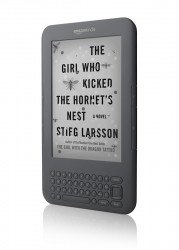I recently purchased a Kobo Wireless e-reader as a backup and for my wife to use. As I mentioned in my review of it, it is generally a capable e-reader, but I prefer my Kindle 3. However, the Kobo has one feature that the Kindle currently lacks: it is compatible with the system OverDrive uses to enable library e-book lending. (Today Amazon announced that library e-book lending is coming to the Kindle later this year.)
Library e-book lending has several advantages — and several disadvantages — over borrowing a book from a traditional library. On the plus side, you don’t have to physically visit the library to browse or check out a book (although some publishers are pushing for this restriction!). Similarly, you don’t have to return the book — it will simply disappear from your e-reader when the lending period (usually 14 or 21 days) is over. Also, the e-book file you get will be pristine — no germs or markings or torn pages.
On the other hand, publishers insist on certain restrictions on e-book lending. First, just getting started is inordinately difficult, and probably impossible for people who aren’t tech savvy. In addition to getting a normal library card (lending is performed through the library you already belong to or may join), you also need to register online through your library and the OverDrive library system. Then, you need to download Adobe Digital Editions, which is the software that will authorize the e-books to be read on your e-reader. Then you need to sign up for an account with Adobe. Then you find and “check out” the e-book you want (this is the most straightforward part of the process), then download the file to Adobe Digital Editions, connect your e-reader, authorize it using the software, and (finally!) transfer the e-book over. No, your parents probably won’t be able to do all this on their own (well, unless your parents are way better with technology than mine are). 😉
Luckily, I am tech-savvy, so I tried the process out. Getting everything set up took an hour or so of fiddling around, downloading things, reading instructions, entering library card numbers, creating accounts, etc. Then I tried the two libraries I’m already a member of: my city library and the county library.
At the city library (which is the nicest library I’ve ever been to), things weren’t so good online. They don’t use OverDrive, but instead use a service called NetLibrary. The first thing I noticed about NetLibrary is that they wanted me to read e-books on my LCD computer screen, instead of the far superior (for reading) and more portable e-Ink screen of my e-reader. A bad start. It turns out they had a handful of e-books available for download to an e-reader, but they all seemed to be computer programming manuals. Bottom line: I couldn’t find one single e-book available for download that I had any interest in reading.
Next I tried my county library. Their website connected me to OverDrive, which seemed to have a better selection. However, as I searched for e-book after e-book, none of them were available. I finally found a few, but they were all in audiobook instead of e-book format. I eventually found a couple of titles that looked interesting, but all in all the selection was pretty desolate.
Finally, I tried the library system of the next county over. They also used OverDrive, and had a larger selection than the first two (each library maintains its own collection of e-book titles through OverDrive, so even though they use the same system, the selection at each individual library may vary greatly). I actually found a few e-books I was interested in checking out. But only a few: maddeningly, many of the ones I wanted were still available only as audiobooks, and a few series I wanted to read were missing the early books but had later books in the series.
In addition, due to restrictions placed on them by publishers, libraries can only loan each copy of an e-book they’ve purchased out to one person at a time. They have to wait until that copy is returned before lending it out again (they can, of course, purchase multiple copies). On the one hand, this restriction seems reasonable, although it simply copies the print book model when there’s no inherent reason to do so. (Why not allow unlimited check-outs, and just charge the library 50 cents per loan, for example? Or allow X loans per year but allow them to overlap?) In practice, this means that e-books you want to read may already be checked out, and you can be added to a waiting list and be notified when it’s your turn.
All in all, library e-book lending isn’t anything like the “free e-books forever” ideal many people might have in their head when thinking about the feature. It’s cumbersome to set up and use, and the selection (both due to books that are checked out and a limited selection of titles) is underwhelming. But it does work, and is another way to get free content onto your e-reader. My advice: check out the e-book selection at your local library (or any other library you can join; some will allow out-of-area residents to join for a fee) to see if they have books you’re interested in before buying an e-reader based on its ability to read library e-books.





